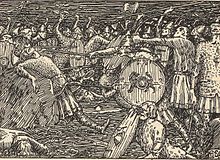Battle of Stiklestad

The Battle of Stiklestad on July 29, 1030 near the small town of Stiklestad in the municipality of Verdal ( Trøndelag , about 90 km north of Trondheim ) finally sealed the complete Christianization and the establishment of Norway . It is one of the most famous battles in Norwegian history.
background
Until 1028 the Christian Olav II. Haraldsson was King of Norway. Around the year 1020 he made Christianity the official religion of Norway. However, because of the forced Christianization there were upheavals with the rebellious nobles, many more powerful citizens fled to the Danish-English king, Canute the Great . He landed in Norway in 1028 with a fleet of 50 ships and he used Håkon Eiriksson as Jarl . King Olav, on the other hand, fled first to Sweden and later to the area around Veliky Novgorod .
battle
After the installed Jarl Håkon Eiriksson drowned in 1029, Norway had become leaderless and Olav Haraldsson saw the chance to become king again. He left his son Magnus I at the royal court in Novgorod and formed a Christian army on his journey through Sweden. With this he moved into Trøndelag and met a peasant army in Verdal, which was probably twice as strong and presumably also a majority Christian. The Icelandic historian Snorri Sturluson put the army size at 3600 to 7000 men about 200 years later. However, researchers now suspect that these numbers are set too high and that there were more likely a few hundred participants.
Olav fell in battle and the peasant army emerged victorious. Olav's body was brought to Nidaros, now Trondheim . As a number of miracles supposedly occurred, Olav was canonized as early as 1035 and he is therefore also called Saint Olav from now on.
Aftermath
With Olav Haraldsson's death, all of Norway became part of the Danish Empire. After the death of Canute the Great in 1035, however, the Anglo-Scandinavian Empire began to fall apart and the nobles who had previously passed to Canute the Great turned away from the Danish royal family. Instead, they installed Olav's son Magnus as the new King of Norway, whom they brought from Novgorod.
The battle today marks the introduction of Christianity into Norway. The importance of the battle was symbolically exaggerated by subsequent generations, especially in the 19th and 20th centuries, by associating it with the idea of a unified Norwegian nation .
Harald, Olav's half-brother, who was only fifteen at the time of the battle, survived the battle and escaped to Sweden. After 17 adventurous years, in Novgorod and Byzantium , he was to return and ascend the Norwegian throne. He went down in history as Harald the Harte .
Others
The church of Stiklestad was built at the place where he died in around 1180. Every year on July 29th, the “St Olav Drama” ( Spelet om Heilag Olav ) is performed in the Stiklestad National Cultural Center .
literature
- The Council of Europe: Follow the Vikings. Visby 1996, ISBN 91-972916-0-9 , p. 31.
Web links
- National Cultural Center Stiklestad (Norwegian)
- Battle of Stiklestad in the store norske leksikon (Norwegian)
Individual evidence
- ↑ Unn Pedersen, Jon Vidar Sigurdsson: Landet blir kristnet - Norgeshistorie. Universitetet i Oslo, accessed February 23, 2020 (Norwegian).
- ^ Slaget på Stiklestad. In: stiklestad.no. Retrieved February 23, 2020 (Bokmål in Norwegian).
- ^ Slaget ved Stiklestad | Gyldendal - The Danske store. The Danske Encyklopædi store , accessed on February 23, 2020 (Danish).
- ↑ Bjørn Bandlien, Per G. Norseng: Olav den bright . In: Store norske leksikon . November 19, 2019 ( snl.no [accessed February 23, 2020]).
- ↑ Knut A. Rosvold: Slaget på Stiklestad . In: Store norske leksikon . October 31, 2018 ( snl.no [accessed February 23, 2020]).
- ↑ Hans Jacob Orning: Kongesagaer - bruk av problematiske kilder - Norgeshistorie. Universitetet i Oslo, February 14, 2019, accessed on February 23, 2020 (Norwegian).
- ^ Saint Olav - King of Norway. The katolske kirke, accessed on February 23, 2020 (English).
- ↑ Hans Jacob Orning: Harald Hårfagre og Danmark - Norge history. Universitetet i Oslo, November 25, 2015, accessed February 23, 2020 (Norwegian).
- ↑ Hans Jacob Orning: Fire continued Ellinger om Stiklestad - Norge history. Universitetet i Oslo, May 25, 2018, accessed February 23, 2020 (Norwegian).
- ↑ Knut A. Rosvold: Stiklestad . In: Store norske leksikon . March 20, 2018 ( snl.no [accessed February 23, 2020]).
- ↑ Hans Jacob Orning: Kristen tro i middelbaar alderen - Norge history. November 25, 2015, accessed February 23, 2020 (Norwegian).
- ↑ Kirkesøk - Kirkebyggdatabasen. Retrieved February 23, 2020 (Norwegian).
- ↑ Helene Solheim: Kutt i Spelet om Heilag Olav - blir truleg arrangert annakvart år. NRK, October 21, 2019, accessed on February 23, 2020 (Norwegian Nynorsk).
Coordinates: 63 ° 47 ′ 48 ″ N , 11 ° 34 ′ 0 ″ E